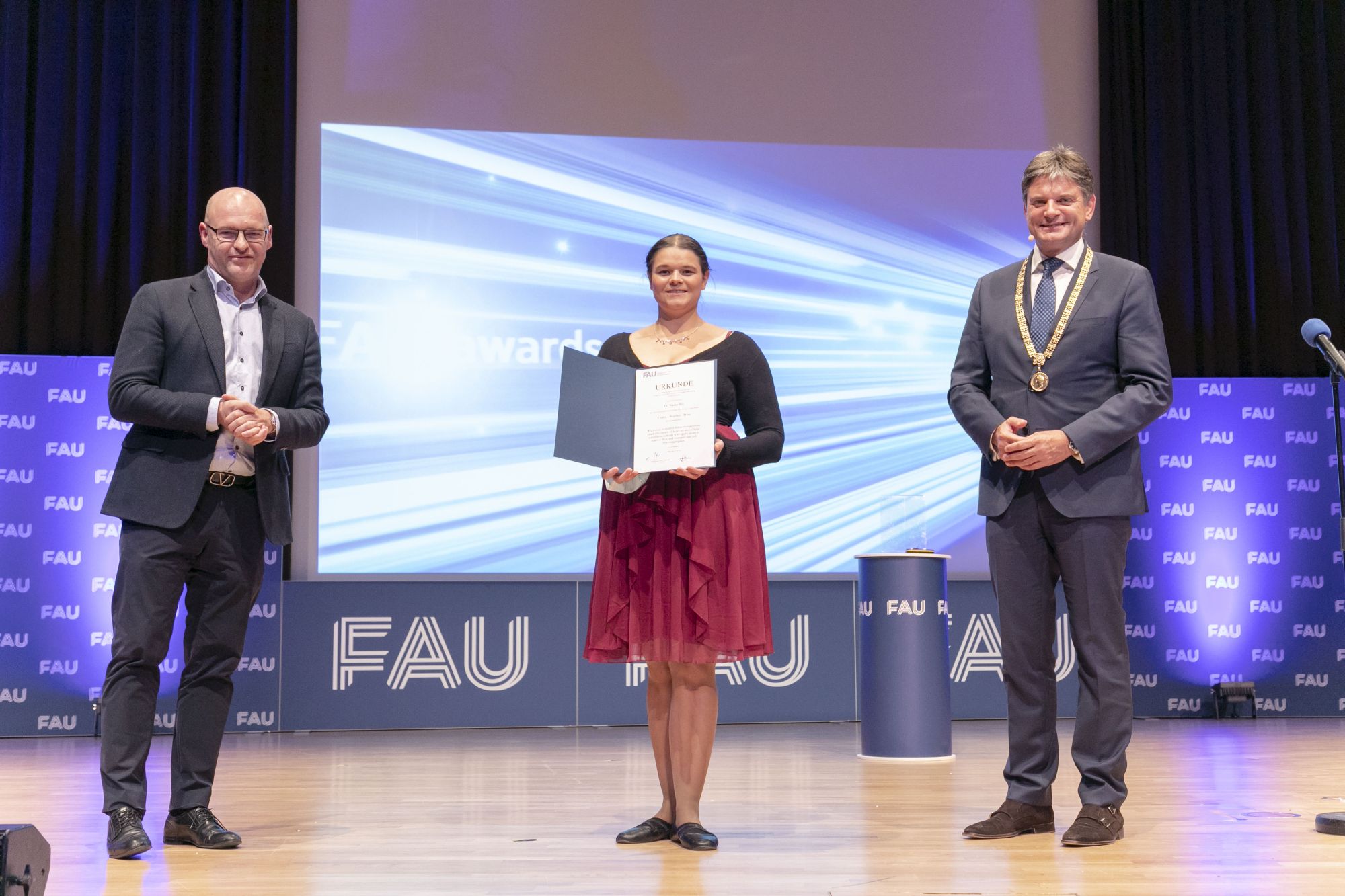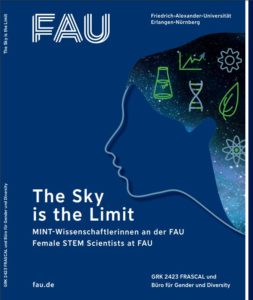Using mathematics to understand the structure of soil

In our series of 22 reports, we present a panorama of female researchers from various qualification levels and academic positions, ranging from students to W3 professors. With their individual career paths, the female researchers in STEM subjects act as role models to encourage young female researchers to pursue an academic career, giving interesting insights into their careers to date. The MINT experts also share aspects of their private lives.
Postdoctoral researcher and head of junior research group Nadja Ray: Using mathematics to understand the structure of soil
For mathematician PD Dr. Nadja Ray, mathematical equations and models have a practical purpose: the researcher and head of a junior research group at the Chair of Applied Mathematics, Modelling and Numerics is investigating porous microstructures in soil within the context of several DFG projects. Her work contributes to protecting the climate and the environment. The 38-year-old Privatdozentin is currently at an exciting stage in her career. Only recently, she was awarded the coveted Habilitation Prize from the Faculty of Sciences during the FAU Awards. That apart, the mathematician, who currently has a permanent position at FAU, has been offered a professorship at the Catholic University of Eichstätt-Ingolstadt, but only on a temporary basis.
Ms Ray, have you decided what to do? Stay at FAU or accept the professorship?
I am delighted to have been offered the professorship. It goes without saying that a professorship offers a number of exciting opportunities. However, there are several points I have to clarify before I can make a decision. Ideally, I would like to take a leave of absence from FAU for these five years and then take it from there. If the professorship came to an end after the five years, I could return to my permanent position at FAU. If the professorship at the Catholic University of Eichstätt-Ingolstadt was made permanent, I could stay there. We’ll need to wait and see what happens …
A permanent position for research staff: is that commonplace?
Normally there are positions as public servants, known as Akademische Räte, but there are not many of them either. I am employed at the university as a member of staff, with teaching duties. Positions like that are a rarity in Germany. It would be good if there were more of them.
Until now, your life has centred around Erlangen…
Yes, I studied here, completed my doctoral degree here and completed my postdoctoral thesis here. I am married, have two children aged eight and four and a half, and I am settled here. At this stage, it is important to me to have a certain degree of financial security and to be able to make reliable plans. I intend to commute if I do take on the position in Ingolstadt.
Congratulations on winning the FAU Habilitation Prize! What was the award ceremony like?
The audience was very small, but it was a lovely event in the Heinrich Lades Halle in Erlangen. The Emmy Noether Prize is awarded each year by the University Association Erlangen-Nuremberg to a talented young researcher for an outstanding postdoctoral thesis at the Faculty of Sciences and also entails prize money. After a brief laudatio and being awarded a certificate by the President, there was a s science slam. I had six minutes to present my thesis. That was a challenge!

Dep. of Mathematics, Chair of Applied Mathematics (Modelling and Numerics) (Image: Giulia Iannicelli/FAU)
Could you describe your research briefly for us here too?
My research focuses on applications in geosciences. I hope to understand the properties and structure of different types of soil. How much water and carbon do they store? How are nutrients or harmful substances transported in the soil? To look at this in more detail, my group and various colleagues design mathematical models, analyse them and run numerical simulations. We hope to gain insights into aspects such as the ideal growth conditions for plants, a particularly relevant area today in view of climate change and battling famine. Precise, conscientious and interdisciplinary working is required.
Mathematics is often associated with the teaching profession. Why did you decide to study applied mathematics?
It is true, a lot of people study mathematics as part of a teaching degree in preparation for a career as a school maths teacher. Other mathematicians choose to go into software development, insurance companies, management consulting or research and development departments in large companies. I decided on an academic career in applied mathematics because I enjoy working independently and the mixture of practical application and at times abstract research appealed to me. My husband works as a mathematician in industry. His working environment is quite different from mine, with very different challenges. Products and solutions have to be delivered and customer requirements met.
How do you cope with juggling a job and a family?
Organisation is key. We have to coordinate well with each other and stick to fixed structures. My husband and I are both very keen to balance work and family commitments, and both chose to work part time when the children were younger. I really appreciate the flexibility offered by the University. I generally work from 8 am until 2.30 pm and then again in the evening or on Saturdays. I have made that clear to everyone I work with. If meetings or committees are scheduled for the late afternoon, then I cannot always attend. You need to set your own boundaries. If something does crop up, we can usually organise things accordingly, or otherwise we are lucky to have my parents and parents in law nearby, who are happy to help.
Which factors have contributed to your success in the STEM area?
I have always liked to work accurately and conscientiously. Every success is based on a high level of commitment and hard work, but support at all levels is also important, whether in the shape of external financial funding, scholarships or mentors who appreciate your worth. I was lucky enough to benefit from all of the above. In addition, you shouldn’t underestimate the value of networks and networking, especially with people in a similar career situation but who are from different areas and may be able to show you a different view of the situation. Thanks to my scholarships, I benefited greatly from opportunities such as these during my studies and whilst working on my doctoral degree. I am currently taking part in the training and qualification programme FAUnext that offers courses on various aspects of my career. I have also been involved as a mentor in the ARIADNE programme.
What tips would you give to other young female researchers?
If you want to stay at the university, you should look to strike a balance between what you’re interested in and a topic that is of relevance to the future that you will be able to find funding for. Also, you should decide at the latest after completing your doctoral degree whether you want to continue to pursue an academic career or not. That is the ideal time to decide which track to pursue. Don’t just take the easy option and decide to do postdoctoral research for the sake of it. It’s not worth it, and is often just a waste of time if you do decide to pursue a non-academic career. The longer you stay at university, the harder it is to branch out in another direction. It makes more sense to either go into industry straightaway after finishing your doctoral thesis or to make a deliberate choice to pursue an academic career. However, women ought to be aware that whilst the ratio of women to men in mathematics is fairly well-balanced up until doctoral degree level, afterwards you have to be prepared to stand up for yourself more.
What do you most appreciate at FAU?
Apart from the fact that I have always felt supported and encouraged every step of the way: FAU is a full-spectrum university and offers a number of options for life-long learning. I really appreciate that at the moment. I am currently studying for a Bachelor’s degree in physics and am attending lectures in data science. I need to do something for my brain that is fun, but not directly connected to my work.
This article is part of the brochure “The Sky is the Limit”

Brochure “The Sky is the Limit”
Diverse, inspiring and innovative, the brochure “The Sky is the Limit” introduces female researchers in STEM subjects from the Faculty of Engineering and the Faculty of Sciences in a series of varied interviews.
Other interviews are available on the Research website.
Download the brochure “The Sky is the Limit — Female STEM scientists at FAU”
The publication is the result of collaboration between RTG 2423 FRASCAL and the Office of Equality and Diversity. Dr. Susanne Stemmler conducted the interviews.